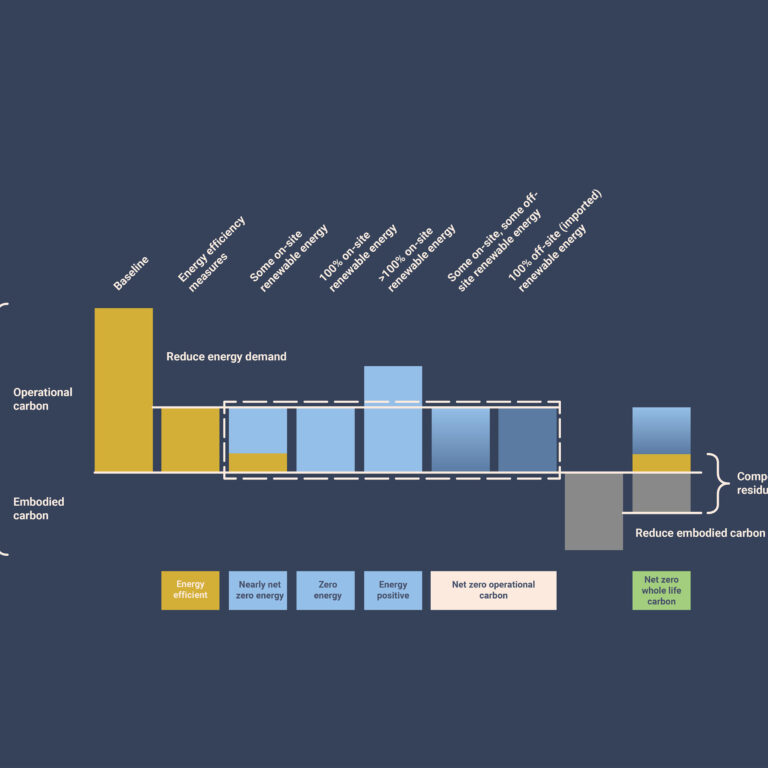In the context of global carbon neutrality, however, the construction industry remains one of the principal sources of carbon emissions. This raises a crucial question: what defines a CO₂-friendly building within the architectural field? Among the many terms, people use net-zero carbon and carbon neutral most frequently—and they often confuse them. Although they sound similar, in practice they refer to distinct approaches. For architects, however, understanding the difference is not just a matter of terminology; it is about setting the right goals for design and communication with clients.
Carbon Neutrality and Net Zero
“Carbon Neutrality”, means having a balance between emitting carbon and absorbing carbon from the atmosphere in carbon sinks. Specifically, experts call the process of removing carbon oxide from the atmosphere and storing it carbon sequestration (European Parliament, 7.9.2022). Consequently, this process usually applies to a specific stage, and buildings can return to this state after a certain time.
“Net Zero”, here means net zero emission, cutting GHG (greenhouse gas) emissions to as close to zero as possible. In addition, oceans and forests re-absorb the remaining emissions from the atmosphere (European Parliament, 7.9.2022). To keep global warming below 1.5°C – as the Paris Agreement calls for – countries must cut emissions by 45% by 2030 and reach net zero by 2050. Therefore, the focus shifts to cutting all GHG emissions and re-absorbing them through two processes.
Net Zero Buildings and Net Zero Carbon Buildings
The term Net Zero Buildings addresses a balance of zero and can serve as a pathway for research into various aspects. These include Zero Energy, Zero Water, Zero Waste, and Zero Carbon. Within this group, in particular, Net Zero Carbon Buildings represent a specific type.
LEED defines a Net Zero Carbon Building as a highly efficient building that achieves a zero balance of operational carbon emissions. As a result, such buildings generate on-site, or procure off-site, enough carbon-free renewable energy each year to meet their operational energy demand (Architecture 2030, 2016).
Meanwhile, the concept of Zero Carbon refers to highly efficient assets that run entirely on 100% renewable energy sources and exclude fossil fuels (WorldGBC, World Green Building Council, n.d.).
The World Green Building Council believes that measuring the carbon of a building, and aiming to cover all energy needs through both on- and off-site renewable sources, is a more realistic and inclusive way to measure a building project’s impact on the environment. This also helps achieve the requirements of the Paris Climate Agreement. It emphasises two aspects: highly efficiency as a basement and zero carbon emissions balance as a result. As the golden rule of achieving Net Zero, architects and planners always prioritise measures that reduce energy demand. They ensure buildings achieve high efficiency.
WorldGBC recognises that in most situations, net zero energy buildings, i.e. buildings that generate 100% of their energy needs on-site, are not feasible. Instead, designers should pursue net zero embodied carbon as part of a whole lifecycle approach to carbon reduction. This includes net zero operational carbon. Therefore a net zero carbon vision that acknowledges the time value of carbon emissions from materials and construction, as well as recognising the role of offsets in facilitating the transition, is more appropriate. Consequently, policymakers and industry leaders need this approach at mass scale to achieve the urgent and significant carbon emission reductions required to align with IPCC guidance.
There is two main guiding principles:
- Net Zero Operational Carbon means that designers reduce annual carbon dioxide emissions from building operations by ensuring high energy efficiency. Full reliance is on on-site and/or off-site renewable energy sources. They must cut emissions to a level consistent with reaching net zero at the global or sector level in 1.5°C pathways. Designers must also neutralise any residual emissions that remain unfeasible to eliminate through carbon removals.
- Net Zero Whole Life Carbon means that designers cut upfront carbon and other embodied carbon across the building lifecycle. They also address net zero operational carbon. They must reduce these emissions to a level consistent with reaching net zero at the global or sector level in 1.5°C pathways. Designers must also neutralise any residual emissions that remain unfeasible to eliminate. Designers achieve this through carbon removals. Advancing net zero whole life carbon, operational carbon, and embodied carbon are two parts of carbon criteria. These should achieve zero balance.
In conclusion, for architectural practice, the distinction is essential. Designing for net-zero carbon means integrating renewable energy, passive design strategies, and efficient systems from the very beginning. Pursuing carbon neutrality, by contrast, involves a wider strategic framework: sustainable material choices, responsible supply chains, and collaboration with clients on offset investments. Misunderstanding these terms can lead to confusion in contracts, misaligned expectations, or even accusations of “greenwashing”. Clear communication ensures that projects deliver on both performance and credibility.
References
- European Parliament (2019). What is carbon neutrality and how can it be achieved by 2050? News | European Parliament, 10 March. Updated 7 September 2022. Archived from the original on 9 January 2023. Available at: https://www.europarl.europa.eu/news/en/headlines/society/20190926STO62270/what-is-carbon-neutrality-and-how-can-it-be-achieved-by-2050 (Accessed: 10 May 2023).
- European Parliament (2022). What is carbon neutrality and how can it be achieved by 2050? News/Society. Available at: https://www.europarl.europa.eu/news/en/headlines/society/20190926STO62270/what-is-carbon-neutrality-and-how-can-it-be-achieved-by-2050 (Accessed: 10 May 2023).
- European Parliament (n.d.). What is carbon neutrality and how can it be achieved by 2050? Available at: https://www.europarl.europa.eu/news/en/headlines/society/20190926STO62270/what-is-carbon-neutrality-and-how-can-it-be-achieved-by-205 (Accessed: 10 May 2023).
- U.S. Green Building Council (n.d.). Net Zero. Available at: https://www.usgbc.org/about/priorities/net-zero (Accessed: 10 May 2023).
- Architecture 2030 (2016). Zero-Net-Carbon: A New Definition. Research & Analysis. Available at: https://architecture2030.org/zero-net-carbon-a-new-definition/ (Accessed: 10 May 2023).
- World Green Building Council (n.d.). Commitment Glossary. Available at: https://worldgbc.org/thecommitment/commitment-glossary/ (Accessed: 10 May 2023).
- World Green Building Council (n.d.). What is a Net Zero Carbon Building? Available at: https://worldgbc.org/advancing-net-zero/what-is-a-net-zero-carbon-building/ (Accessed: 10 May 2023).






